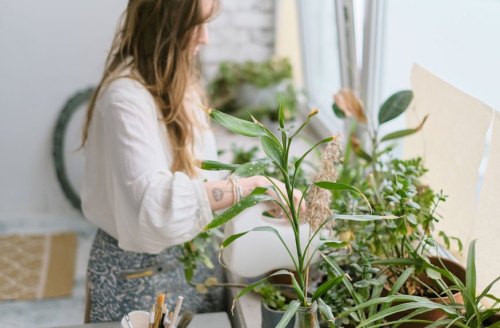Our editors independently select these products. Making a purchase through our links may earn Well+Good a commission
Help your houseplants get properly lit with a super pretty DIY grow light
Houseplants hate the dark days of winter, but they'll love this DIY grow light. Here's how to make one that's cute and affordable.

This winter has been particularly rough for my indoor jungle. My prized monstera, once thriving and cheerful, is now droopy and depressed. With limited sunlight throughout the day, even through south-facing windows of my apartment, I can only do so much to give my plants what they need. Needless to say, I was thrilled to find out that you can fake it with a DIY grow light. Easier to construct than I expected, a grow light will mimic the sun, bathing my plants in all the brightness they deserve.
Grow lights can be expensive, not to mention ugly. While I want my plants to be healthy, I’m averse to the idea of dropping hundreds of dollars on an eyesore. But Adam Besheer, co-owner of Greenery NYC and Greenery Unlimited, has a genius solution. You’ll find his indoor vertical gardens and green walls throughout New York City—all of which depend on grow lights to stay healthy.
“Plants require certain wavelengths of light to grow, and different wavelengths cause different grow patterns. Too much can burn them, but too little and they starve to death,” he tells me. “Grow lights still aren’t as good as sunlight—they still aren’t able to cover the breadth of wavelengths emitted by a burning mass of hydrogen we can’t really conceive the size of. But they’re a great substitute.”
How to build a DIY grow light
When creating your own grow light, there are a few things to consider, such as the aesthetics and the kind of light it will emit. According to Besheer, you can DIY a version that will actually complement your home with something as affordable as a lamp you already own or one from Ikea. (A lamp that hangs over the plants provides plenty of direct light.) You just need to screw in a suitable light bulb, available for about $15 on Amazon, and voilà—it’s done.
“The important thing for a standard grow light is that it’s labelled as a grow light. The brightness you need to keep plants alive isn’t something normal light bulbs are manufactured for,” he says. “LED screw-in bulbs have just become widely available that have a relative intensity that’s good for plants, but to really know, you’ll need to measure the light yourself.”
How to know if your plants are getting enough light
To make sure your plant is getting the exact amount of light it needs, you can measure it using a light meter (which runs for around $20 on Amazon), or you can use the Light Meter app on your phone, which Besheer says gets pretty close to what the actual meter reads. The result will be shown in “foot candles” (or FC), and different plants require different ranges.
On the Greenery NYC website, you can group plants by light requirement: Low-light options like snake plants and pothos require 25 to 75 FC, medium-light plants like monsteras and dracaenas require 75 to 150 FC, and high-light plants like fiddle leaf figs and haworthias require 150+ FC. As for how long they should spend basking in the LED light’s glow every day, Besheer’s go-to is between 10 to 12 hours.
With a little help from a DIY grow light, your indoor plants will be thriving once more. Honestly, I might grab my happy light and sit right there next to ’em.
These are the trendy houseplants taking over in 2019. Or, try this nontoxic routine to rid your plants (and home!) of bugs.
Sign Up for Our Daily Newsletter
Get all the latest in wellness, trends, food, fitness, beauty, and more delivered right to your inbox.
Got it, you've been added to our email list.









